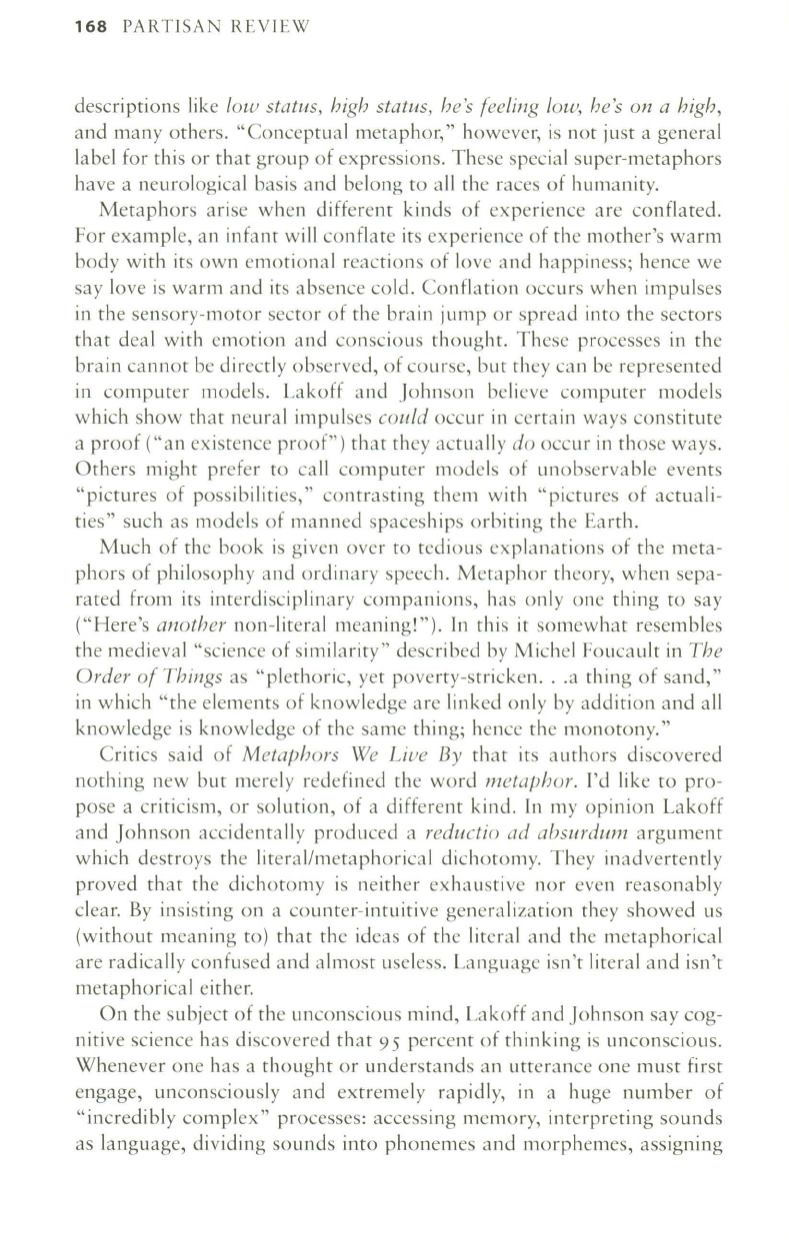
168
PARTISAN REVIEW
descriptions like
low status, high status, he's feeling low, he's on a high,
and many others. "Conceptual metaphor," however, is not just a general
label for this or that group of expressions. These special super-metaphors
have a neurological basis and belong to all the races of humanity.
Metaphors arise when different kinds of experience are conflated.
For example, an infant will conflate its experience of the mother's warm
body with its own emotional reactions of love and happiness; hence we
say love is warm and its absence cold. Conflation occurs when impulses
in the sensory-motor sector of the brain jump or spread into the sectors
that deal with emotion and conscious thought. These processes in the
brain cannot be directly observed, of course, but they can be represented
in computer models. Lakoff and Johnson believe computer models
which show that neural impulses
could
occur in certain ways constitute
a proof ("an existence proof") that they actually
do
occur in those ways.
Others might prefer to call computer models of unobservable events
"pictures of possibilities," contrasting them with "pictures of actuali–
ties" such as models of manned spaceships orbiting the Earth.
Much of the book is given over to tedious explanations of the meta–
phors of philosophy and ordinary speech. Metaphor theory, when sepa–
rated from its interdisciplinary companions, has only one thing to say
("Here's
another
non-literal meaning!"). In this it somewhat resembles
the medieval "science of similarity" described by Michel Foucault in
The
Order of Things
as "plethoric, yet poverty-stricken ...a thing of sand,"
in which "the elements of knowledge are linked only by addition and all
knowledge is knowledge of the same thing; hence the monotony."
Critics said of
Metaphors We Live
By
that its authors discovered
nothing new but merely redefined the word
metaphor.
I'd like to pro–
pose a criticism, or solution, of a different kind. In my opinion Lakoff
and Johnson accidentally produced a
reductio ad absurdum
argument
which destroys the literal/metaphorical dichotomy. They inadvertently
proved that the dichotomy is neither exhaustive nor even reasonably
clear. By insisting on a counter-intuitive generalization they showed us
(without meaning to) that the ideas of the literal and the metaphorical
are radically confused and almost useless. Language isn't literal and isn't
metaphorical either.
On the subject of the unconscious mind, Lakoff and Johnson say cog–
nitive science has discovered that 95 percent of thinking is unconscious.
Whenever one has a thought or understands an utterance one must first
engage, unconsciously and extremely rapidly, in a huge number of
"incredibly complex" processes: accessing memory, interpreting sounds
as language, dividing sounds into phonemes and morphemes, assigning


